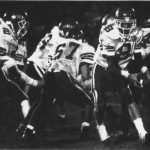BY MARK DEMKO
LIVERPOOL — The Susquehanna is a river of many faces, with rocky outcroppings, underwater ledges, deep pools and even stretches of relatively shallow water, at least in summer.
Few anglers know this iconic smallmouth bass water like Chris Gorsuch, owner of Reel River Adventures, who’s spent more than 20 years on the river, averaging 150 days of angling annually.
What really makes Gorsuch stand out as a fishing guide, however, is that he puts his reputation on the line each and every time he’s out, promising anglers they will put at least 10 bass in the boat or the next outing is free.
“Guys spend a lot of money to go catch fish,” Gorsuch said. “I wanted something that would encourage people to come out with me and know that I’m working hard.
“By telling you that I guarantee 10 bass, 12 inches or better, it makes you want to go out and know that even on a slow day that I’m not taking a vacation. I’m taking you to the very best water I know every day, every time you’re on the boat.”
As a guide, Gorsuch spends late winter through spring on the Susquehanna’s catch-and-release, no-harvest stretch, primarily from Harrisburg upriver to Selinsgrove. During the summer, he migrates to the North Branch because he feels the angling experience and bass numbers are better.
“The North Branch is more enjoyable because there are fewer boats, there’s more variety of water and there’s less pressure,” Gorsuch said. “You have the opportunity to not just catch bass, but pike, musky, walleye and other species that are out there.”
When it comes to river fishing for smallmouth, most anglers know the post spawn often requires different angling tactics than the rest of the summer. Gorsuch notes that many times anglers think they can finesse fish coming out of the spawn, but that isn’t always the case.
“Generally, what happens is these fish kind of get into a zone where the females go off the nest and they take several days to recover,” Gorsuch said. “During that recovery time, the best way to get them is to get them in that reaction strike when they tend to be in deeper water.
“They’re not on ambush points and you’re going to be broadcasting by casting to different areas to try and find out where these fish are. If I find fish on hard cover in five foot of water, I’m going to focus on hard or soft cover until that starts to fail.”
As far as his regular summertime routine for catching fish, Gorsuch keeps 10 rods ready to go for clients, with spinnerbaits, top-waters and soft plastics all part of the arsenal. He tries to locate bass right away by throwing larger crankbaits or spinnerbaits to draw reaction strikes from aggressive individuals.
“Once you locate the fish, you can then find the fish that are more prone to eat by throwing swim baits, tubes, grubs or other finesse styles to pick apart the spot more technically,” Gorsuch said. “Instead of catching one or two bass out of an area, you might catch six, seven, eight, nine or even 10 bass out of one anchor point.”
Gorsuch notes another key for summertime success is being willing to adjust location, even if it’s a matter of only a few yards. He’ll often start off at first light by throwing toward the banks to entice fish near the shoreline into striking, but make subtle adjustments as needed.
“As the sun comes up, the bass that were feeding on the bank overnight and early morning are now in that same location, but they’ve just moved off the bank 25 to 50 yards,” Gorsuch said. “A lot of times I’ll see guys fishing and the bass are under the boat and they don’t even realize it, but if they had cast to the opposite side — not to the bank — they would have found they were on top of the fish because they moved out due to the sunlight.”
For individuals looking to latch onto a hefty bronzeback, Gorsuch suggests larger spinnerbaits, crankbaits and top-water lures.
“We are going to throw the biggest baits and loudest baits we can to kind of stir up those bigger fish,” Gorsuch said.
“Sometimes when you get one to go on a crankbait, you can follow up with a finesse bait and catch big fish as well.
“A lot of time people think the biggest fish bite first, but I find in the summertime the smaller fish are much more aggressive and they care less about what they’re eating. They don’t care about the presentation — they just go and attack it.
“After you find that there are fish there, you can go back and polish that area, work it over a little harder, and throw different baits and different profiles until you can get that big fish.”
Information about a trip with Reel River Adventures is available by contacting Chris Gorsuch at chris.d.gorsuch@gmail.com or 610-360-5433, and his daily fishing reports are posted at Reel River Adventures-RRA on Facebook.
Demko is a member of the Pennsylvania (Outdoor Writers Association. Contact the writer: outdoors@republicanherald.com



